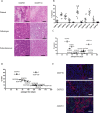Targeting hypoxic microenvironment of pancreatic xenografts with the hypoxia-activated prodrug TH-302
- PMID: 27248663
- PMCID: PMC5085103
- DOI: 10.18632/oncotarget.9654
Targeting hypoxic microenvironment of pancreatic xenografts with the hypoxia-activated prodrug TH-302
Abstract
Previous reports have suggested that the hypoxic microenvironment provides a niche that supports tumor stem cells, and that this might explain clinical observations linking hypoxia to metastasis. To test this, we examined the effects of a hypoxia-activated prodrug, TH-302, on the tumor-initiating cell (TIC) frequency of patient-derived pancreatic xenografts (PDX).The frequencies of TIC, measured by limiting dilution assay, varied widely in 11 PDX models, and were correlated with rapid growth but not with the levels of hypoxia. Treatment with either TH-302 or ionizing radiation (IR), to target hypoxic and well-oxygenated regions, respectively, reduced TIC frequency, and the combination of TH-302 and IR was much more effective in all models tested. The combination was also more effective than TH-302 or IR alone controlling tumor growth, particularly treating the more rapidly-growing/hypoxic models. These findings support the clinical utility of hypoxia targeting in combination with radiotherapy to treat pancreatic cancers, but do not provide strong evidence for a hypoxic stem cell niche.
Keywords: TH-302; hypoxia; pancreatic cancer; patient-derived xenograft; tumor-initiating cells.
Conflict of interest statement
The authors have no conflict of interest to report.
Figures



Similar articles
-
Hypoxia-Activated Prodrug TH-302 Targets Hypoxic Bone Marrow Niches in Preclinical Leukemia Models.Clin Cancer Res. 2016 Apr 1;22(7):1687-98. doi: 10.1158/1078-0432.CCR-14-3378. Epub 2015 Nov 24. Clin Cancer Res. 2016. PMID: 26603259 Free PMC article.
-
Evaluation of the "steal" phenomenon on the efficacy of hypoxia activated prodrug TH-302 in pancreatic cancer.PLoS One. 2014 Dec 22;9(12):e113586. doi: 10.1371/journal.pone.0113586. eCollection 2014. PLoS One. 2014. PMID: 25532146 Free PMC article.
-
Radiotherapy Synergizes with the Hypoxia-Activated Prodrug Evofosfamide: In Vitro and In Vivo Studies.Antioxid Redox Signal. 2018 Jan 10;28(2):131-140. doi: 10.1089/ars.2017.7106. Epub 2017 Sep 8. Antioxid Redox Signal. 2018. PMID: 28741367 Free PMC article.
-
Evofosfamide, a new horizon in the treatment of pancreatic cancer.Anticancer Drugs. 2016 Sep;27(8):723-5. doi: 10.1097/CAD.0000000000000386. Anticancer Drugs. 2016. PMID: 27232101 Review.
-
Bioreductive prodrugs as cancer therapeutics: targeting tumor hypoxia.Chin J Cancer. 2014 Feb;33(2):80-6. doi: 10.5732/cjc.012.10285. Epub 2013 Jul 12. Chin J Cancer. 2014. PMID: 23845143 Free PMC article. Review.
Cited by
-
Hypoxia: Friend or Foe for drug delivery in Pancreatic Cancer.Cancer Lett. 2020 Nov 1;492:63-70. doi: 10.1016/j.canlet.2020.07.041. Epub 2020 Aug 18. Cancer Lett. 2020. PMID: 32822815 Free PMC article. Review.
-
Impact of Tumour Hypoxia on Evofosfamide Sensitivity in Head and Neck Squamous Cell Carcinoma Patient-Derived Xenograft Models.Cells. 2019 Jul 13;8(7):717. doi: 10.3390/cells8070717. Cells. 2019. PMID: 31337055 Free PMC article.
-
Hypoxia, a Targetable Culprit to Counter Pancreatic Cancer Resistance to Therapy.Cancers (Basel). 2023 Feb 15;15(4):1235. doi: 10.3390/cancers15041235. Cancers (Basel). 2023. PMID: 36831579 Free PMC article. Review.
-
Tumor Hypoxia As an Enhancer of Inflammation-Mediated Metastasis: Emerging Therapeutic Strategies.Target Oncol. 2018 Apr;13(2):157-173. doi: 10.1007/s11523-018-0555-4. Target Oncol. 2018. PMID: 29423593 Review.
-
Clinical Limitations of Photon, Proton and Carbon Ion Therapy for Pancreatic Cancer.Cancers (Basel). 2020 Jan 9;12(1):163. doi: 10.3390/cancers12010163. Cancers (Basel). 2020. PMID: 31936565 Free PMC article. Review.
References
-
- Brown JM. Tumor microenvironment and the response to anticancer therapy. Cancer BiolTher. 2002;1:453–58. - PubMed
-
- Brown JM. Tumor hypoxia in cancer therapy. Methods Enzymol. 2007;435:297–321. - PubMed
-
- Yokoi K, Fidler IJ. Hypoxia Increases Resistance of Human Pancreatic Cancer Cells to Apoptosis Induced by Gemcitabine. Clin Cancer Res. 2004;10:2299–2306. - PubMed
-
- Busk M, Horsman MR. Relevance of hypoxia in radiation oncology: pathophysiology, tumor biology and implications for treatment. Q J Nucl Med Mol Imaging. 2013;57:219–34. - PubMed
MeSH terms
Substances
LinkOut - more resources
Full Text Sources
Other Literature Sources
Medical

